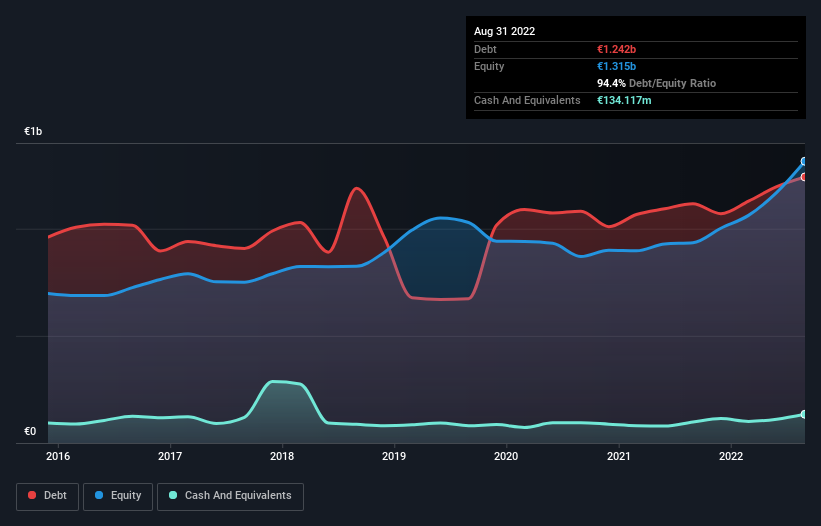
Some say volatility, rather than debt, is the best way to think about risk as an investor, but Warren Buffett famously said that 'Volatility is far from synonymous with risk.' So it might be obvious that you need to consider debt, when you think about how risky any given stock is, because too much debt can sink a company. As with many other companies Gerresheimer AG (ETR:GXI) makes use of debt. But the more important question is: how much risk is that debt creating?
Why Does Debt Bring Risk?
Debt assists a business until the business has trouble paying it off, either with new capital or with free cash flow. If things get really bad, the lenders can take control of the business. While that is not too common, we often do see indebted companies permanently diluting shareholders because lenders force them to raise capital at a distressed price. Of course, plenty of companies use debt to fund growth, without any negative consequences. When we examine debt levels, we first consider both cash and debt levels, together.
Our analysis indicates that GXI is potentially undervalued!
How Much Debt Does Gerresheimer Carry?
As you can see below, at the end of August 2022, Gerresheimer had €1.24b of debt, up from €1.12b a year ago. Click the image for more detail. However, it does have €134.1m in cash offsetting this, leading to net debt of about €1.11b.

How Healthy Is Gerresheimer's Balance Sheet?
According to the last reported balance sheet, Gerresheimer had liabilities of €1.10b due within 12 months, and liabilities of €1.13b due beyond 12 months. Offsetting this, it had €134.1m in cash and €299.0m in receivables that were due within 12 months. So its liabilities outweigh the sum of its cash and (near-term) receivables by €1.79b.
This deficit is considerable relative to its market capitalization of €2.18b, so it does suggest shareholders should keep an eye on Gerresheimer's use of debt. Should its lenders demand that it shore up the balance sheet, shareholders would likely face severe dilution.
We use two main ratios to inform us about debt levels relative to earnings. The first is net debt divided by earnings before interest, tax, depreciation, and amortization (EBITDA), while the second is how many times its earnings before interest and tax (EBIT) covers its interest expense (or its interest cover, for short). The advantage of this approach is that we take into account both the absolute quantum of debt (with net debt to EBITDA) and the actual interest expenses associated with that debt (with its interest cover ratio).
With net debt to EBITDA of 3.5 Gerresheimer has a fairly noticeable amount of debt. But the high interest coverage of 7.3 suggests it can easily service that debt. One way Gerresheimer could vanquish its debt would be if it stops borrowing more but continues to grow EBIT at around 15%, as it did over the last year. There's no doubt that we learn most about debt from the balance sheet. But ultimately the future profitability of the business will decide if Gerresheimer can strengthen its balance sheet over time. So if you're focused on the future you can check out this free report showing analyst profit forecasts.
But our final consideration is also important, because a company cannot pay debt with paper profits; it needs cold hard cash. So we always check how much of that EBIT is translated into free cash flow. In the last three years, Gerresheimer created free cash flow amounting to 2.9% of its EBIT, an uninspiring performance. That limp level of cash conversion undermines its ability to manage and pay down debt.
Our View
Both Gerresheimer's conversion of EBIT to free cash flow and its level of total liabilities were discouraging. At least its EBIT growth rate gives us reason to be optimistic. Taking the abovementioned factors together we do think Gerresheimer's debt poses some risks to the business. So while that leverage does boost returns on equity, we wouldn't really want to see it increase from here. There's no doubt that we learn most about debt from the balance sheet. But ultimately, every company can contain risks that exist outside of the balance sheet. For example, we've discovered 2 warning signs for Gerresheimer (1 doesn't sit too well with us!) that you should be aware of before investing here.
If you're interested in investing in businesses that can grow profits without the burden of debt, then check out this free list of growing businesses that have net cash on the balance sheet.
New: Manage All Your Stock Portfolios in One Place
We've created the ultimate portfolio companion for stock investors, and it's free.
• Connect an unlimited number of Portfolios and see your total in one currency
• Be alerted to new Warning Signs or Risks via email or mobile
• Track the Fair Value of your stocks
Have feedback on this article? Concerned about the content? Get in touch with us directly. Alternatively, email editorial-team (at) simplywallst.com.
This article by Simply Wall St is general in nature. We provide commentary based on historical data and analyst forecasts only using an unbiased methodology and our articles are not intended to be financial advice. It does not constitute a recommendation to buy or sell any stock, and does not take account of your objectives, or your financial situation. We aim to bring you long-term focused analysis driven by fundamental data. Note that our analysis may not factor in the latest price-sensitive company announcements or qualitative material. Simply Wall St has no position in any stocks mentioned.
About XTRA:GXI
Gerresheimer
Manufactures and sells medicine packaging, drug delivery devices, and solutions in Germany and internationally.
Good value with reasonable growth potential and pays a dividend.

